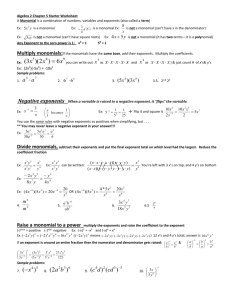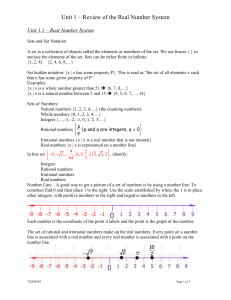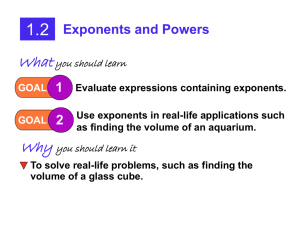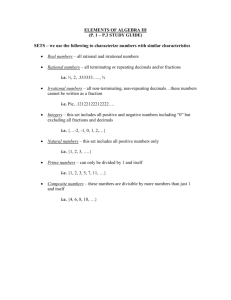LIKE-TERMS-AND-EXPONENTS
advertisement
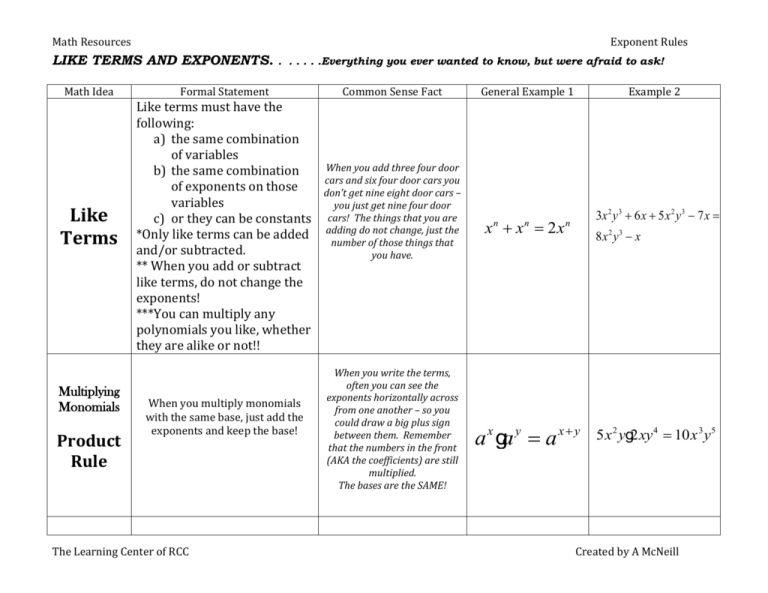
Math Resources Exponent Rules LIKE TERMS AND EXPONENTS. . . . . . .Everything you ever wanted to know, but were afraid to ask! Math Idea Formal Statement Like Terms Like terms must have the following: a) the same combination of variables b) the same combination of exponents on those variables c) or they can be constants *Only like terms can be added and/or subtracted. ** When you add or subtract like terms, do not change the exponents! ***You can multiply any polynomials you like, whether they are alike or not!! Multiplying Monomials Product Rule When you multiply monomials with the same base, just add the exponents and keep the base! The Learning Center of RCC Common Sense Fact When you add three four door cars and six four door cars you don’t get nine eight door cars – you just get nine four door cars! The things that you are adding do not change, just the number of those things that you have. When you write the terms, often you can see the exponents horizontally across from one another – so you could draw a big plus sign between them. Remember that the numbers in the front (AKA the coefficients) are still multiplied. The bases are the SAME! General Example 1 x x 2x n n Example 2 3x 2 y 3 6x 5x 2 y 3 7x n 8x 2 y 3 x a x ga y a x y 5x 2 yg2xy 4 10x 3 y5 Created by A McNeill Math Resources Raising a Monomial to Power Power Rule Exponent Rules When you raise a monomial term to some power, multiply the exponents When you divide two monomial terms with the same base subtract the exponents, and keep the base! Dividing a Monomial by a Monomial Quotient Rule The Learning Center of RCC When you write the monomial it is inside parentheses and the exponent is outside of the parentheses and this could serve as a reminder to you to multiply them. Note that the coefficients are raised to the power as well! When you divide monomials, always remember to divide the coefficients or reduce them to their lowest terms. Note that when you subtract your exponents that your base will always end up where the larger exponent is located. If the larger exponent is in the numerator, subtract the exponents and write your base and the new exponent (the difference) in the numerator. If the larger exponent is in the denominator, then subtract and place your base and the new exponent in the denominator! a a m n 6x y z 6 (x ) y z 3 2 4 2 mgn a mn 2 3 2 2 2 4 2 36x 6 y 4 z 8 28x 8 y5 4x 5 35x 3 y 7 5y2 am m n a an Created by A McNeill Math Resources Zero Exponent Rule Exponent Rules When you raise anything to the zero power the answer is 1! When you have a power of 0, it is telling you that you have none of that base – you only have the “understood” coefficient 1. So since you have none of that base all you have left is the coefficient 1. Also consider the quotient rule and note the following: 2 x 1 x2 x22 1 6x 0 1 a 1 0 x0 1 Negative Exponent Rule Fractions Raised to Negative Exponents When you raise any base to a negative exponent ; it is the same as raising the reciprocal of that base to the positive exponent! When you raise a fraction to a negative exponent, write the reciprocal of the fraction and write the positive exponent The Learning Center of RCC When you have a negative exponent, it creates a reciprocal; by flipping the current base over and replacing the negative exponent with a positive exponent. Be careful that you notice which numbers and terms are being raised to the negative exponents and which ones are not! When your base is a fraction, flip the fraction (write its reciprocal) then apply the positive exponent to the numerator and the denominator . 1 an 1 an n a 1 an a b n b a 2 3 4 6x y z n 7x 2 6y 3 6y 3 2 4 x z 6y 2 7x 3 63 y3 216y 3 7 3 (x 2 )3 343x 6 Created by A McNeill Math Resources The Learning Center of RCC Exponent Rules Created by A McNeill





